AFL: Adelaide Crows great Tony Modra reflects on his stunning 1993 season
Tony Modra was one of the original pin-ups of the AFL era, and, in his break-out 1993 season, the ‘Modra-mania’ that followed him was unprecedented.
AFL
Don't miss out on the headlines from AFL. Followed categories will be added to My News.
Hairs on the back of Tony Modra’s neck stand up as he tries to compose himself to take his shot at the southern end at Football Park.
The Adelaide full-forward has just soared above North Melbourne duo Ian Fairley and Glenn Archer to grab a stunning mark in the goalsquare of the clubs’ match in round 8, 1993.
Modra is already on his way to a level of stardom the likes of which South Australia has rarely seen, having kicked 39 majors from his first six games that season.
But this moment, which is later deemed Mark of the Year, and his 10-goal performance in a thrilling Crows comeback from a 26-point three-quarter time deficit send the high flyer’s popularity soaring.
In the commentary box, Bruce McAvaney says: “Give him the key to the city”.
In the stands, the crowd of 45,562 rise to their feet.
“It’s one of those things I’ll always remember,” Modra, now 54, recalls.
“The reaction from the crowd was pretty special.
“It made the hairs on the back of my neck stand up.
“After that mark, it was one of these things where I know the crowd enjoyed and loved it – what do they say in Gladiator ‘Win the crowd’.
“That’s why I enjoyed playing football, for those sort of moments … so I kept trying to do it.”
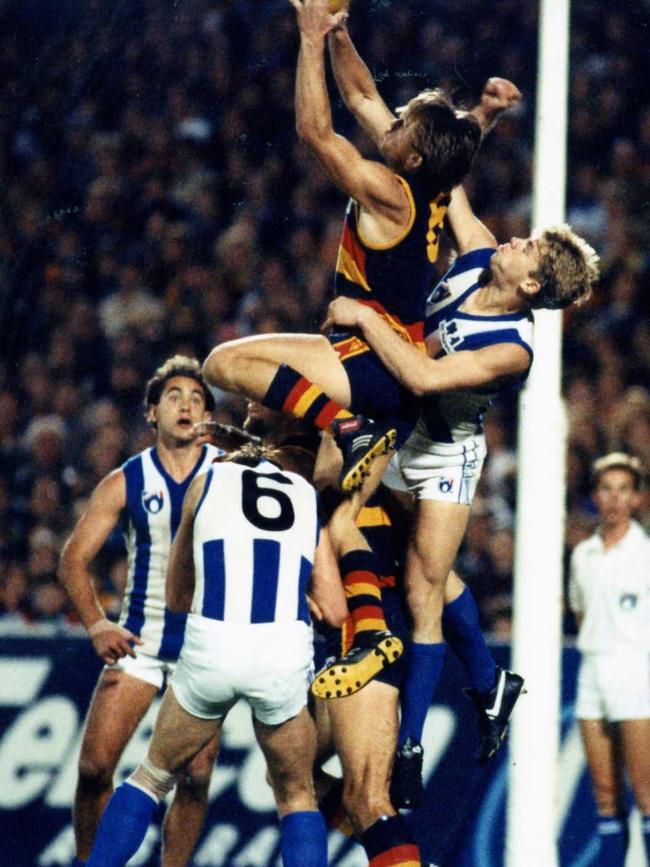
Modra began his rapid rise in the Crows’ first match that year by kicking 10 goals against Richmond at the MCG, a game he played only by chance.
Teammate Scott Hodges was the pre-eminent full-forward locally in that era – he slotted a SANFL record 153 goals for Port Adelaide in a Magarey Medal-winning 1990 campaign – but was sidelined with injury.
Modra, who had booted 21 majors from eight matches in his debut AFL season in 1992, was yet to make his mark.
“You do look at that as a sliding-doors moment,” Modra says of Hodges’ injury.
“People say you have to make the most of your opportunities and I guess that’s what I did.
“I was attacking the ball as hard as I could and my hands were sticking.
“The confidence from that game led me for the rest of the year.”
Modra kicked six goals in a win over West Coast the next week.
“I wanted to make sure it wasn’t just a once off,” he says.

Then Modra booted another six majors in a one-point home triumph against Fitzroy that left Adelaide with a 3-3 record.
The Crows lost their next three matches, leading up to that round 8 meeting with North Melbourne.
Modra maintained his form, kicking five, seven and five majors.
“I was never happy coming off the ground with under five,” he says.
“(Former Woodville player and Riverland opponent Barry) ‘Buff’ Tyrrell told me ‘a handful is always good on a day’.
“I was the sort of player that always knew what the other full-forward had (kicked) to quarter-time and halftime – I was competitive like that.”
WHERE IT ALL STARTED
Modra always had an eye for goals.
He grew up playing soccer, as a striker, at school in Christies Beach, south of Adelaide.
That served him well years later at AFL level.
“I know it was a bit harder to kick because it wasn’t a round shape, but if you saw the ball on the ground, you’d try to read the ball and the bounce, and it came off more times than others,” he says.
When Modra and his family moved to the Riverland, he pursued Aussie rules.
“We sold up down at Port Noarlunga and were going to travel around Australia, so we had the caravan on the back,” he says.
“We got three hours out of Adelaide and that was it – we got to Loxton and dad became the manager of Loxton caravan park for three years.”
After playing juniors for West Adelaide, Modra returned to the Riverland to line up for Loxton then joined his brothers Kym and Rick at Renmark, where the future Crow kicked 118 goals in a premiership season.
“I was pretty much a goalkicker all my life,” he says.
“From the half-forward flank when I was smaller, then I went to centre half-forward and full-forward, so didn’t really venture past the half-forward line.”
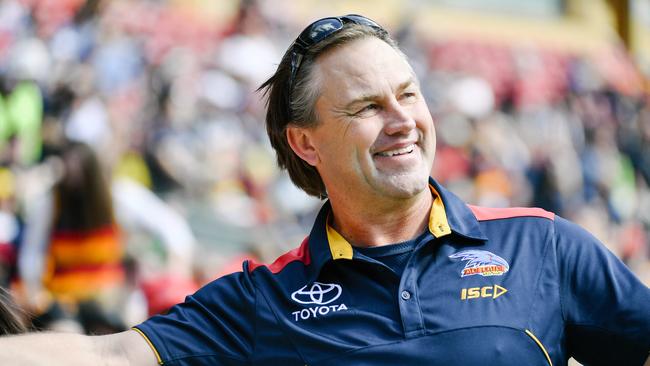
It was Tyrrell, a star goalkicker at Barmera, who set him on the path to the big league.
“He was the one who told me I was wasting my time up there,” says Modra, who rejoined West Adelaide in 1991.
“That opened my eyes a bit.”
As Modra made his way through the ranks, spectacular forwards, such as St Kilda’s Trevor Barker, were his favourite players.
“When I was in the footy club back in Loxton and Renmark I couldn’t wait to watch The Winners, seeing (Tony) Lockett, (Gary) Ablett, (Jason) Dunstall and how many they’d kicked,” he says.
“I didn’t realise a few years later I was going to be at the opposite end of the ground to them, which was a privilege.”
ROAD TO STARDOM
Modra’s goalkicking exploits put him in the Coleman Medal race with Ablett and Dunstall.
That along with his spectacular marks, popularity with fans of all ages and the Crows’ success helped spark Modra Mania across South Australia that year.
Coach Graham Cornes described him at the time as “the highest profile sportsman we’ve ever had in that state”.
“I didn’t read too much into that,” Modra says now of Cornes’s comments.
“Whenever someone asks who my favourite coach was I always say Cornesy because he gave me my first chance.
“He gave me a couple of chances actually.
“Every now and then I’d miss training, the alarm wouldn’t go off, something like that.”
Modra-inspired banners became a regular sight in the Football Park crowd during 1993.
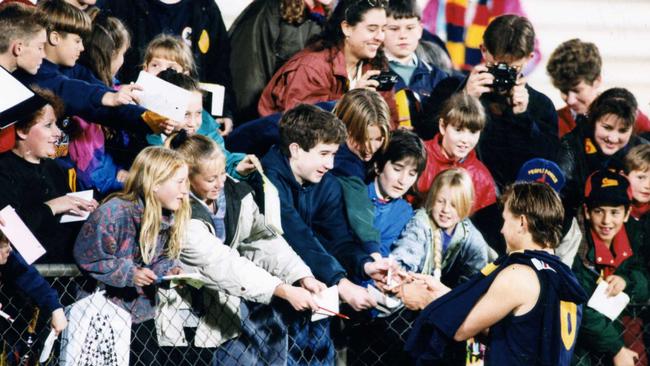
‘Godra’ ones were common.
“There was a banner that was up once saying ‘Marry Me Modra’, which was funny,” he says.
Modra was in a relationship with his now wife, Erica, in 1993, as he became one of the most sought after players in the competition, a star of TV commercials – “when I wasn’t wearing surf clothes, I was wearing suits” – and was mobbed across the state.
“It was an interesting experience and it’s made us both stronger,” he says.
Leaving his house started proving more difficult that year because of the attention he received.
The adulation was such that Modra had a few stalkers that would “rock up at home, ring the doorbell and things”.
“Every now and then someone would follow you home, which was a bit hard, but the club and Rusty my bull terrier dog soon sorted that out,” Modra says.
“All Rusty had to do was look at them and they’d get scared.”
Through it all, Modra enjoyed having banter with fans – both Home And Away.
“Every time we went to Melbourne, I’d try to shut the crowd up early,” he says.
The fun continues in his present role as game day host in the Crows’ bunker at Adelaide Oval.
“I still get the odd supporter who comes down and says they were part of the (Godra) banner crew,” he says.
“I tell them thanks for their support, give them a beer and talk about the old days.
“If it wasn’t for the supporters, I wouldn’t be where I am now.”
Modra still gets asked to mimic taking marks on fans’ backs.
“Nowadays it’s easier for them to do it to me,” he says.
ORIGIN OF THE SPECCIES
Leaping above packs, as he did that night over Fairley and Archer, was second nature for Modra.
“I’d been trying to do it since high school,” says Modra, who is 188cm.
“As the kid down the front everyone used to try to sit on yours, so I thought ‘I’m not putting up with this much longer’, so you end up at the back trying to do the same thing.
“If I was riding my bike, I’d just try to jump things.
“I was a high jumper at high school and that probably helped.”
Modra’s 1993 Mark of the Year became extra special a few months after the Kangaroos match when he learnt his sister was sitting a short distance away, behind the southern goals.
“One day I zoomed in (on the footage) and I could see her there jump up,” he says.
“That was the mark that set the scene for me.
“It was just one of those games where I zoned in and the confidence grew after taking that mark.”
COLEMAN MEDAL RACE
Buoyed by that victory over North Melbourne, Adelaide won six of its eight next matches, culminating with a 139-point thrashing of Richmond at Football Park in round 16.
Modra booted 13.4, making it 23 majors that year against the Tigers.
He has a theory behind his stunning 1993 performances against Richmond and North Melbourne.
“I think it had something to do with being comfortable playing against the opposition because Loxton were Tigers and when I played at Renmark they were North Melbourne colours,” he says.
“So there might have been something in it just when I went out there, I didn’t feel intimidated at all and was playing in those colours.”
Modra finished the minor round by kicking four, seven, four, five and five goals, reaching the ton against Fitzroy at Princes Park.
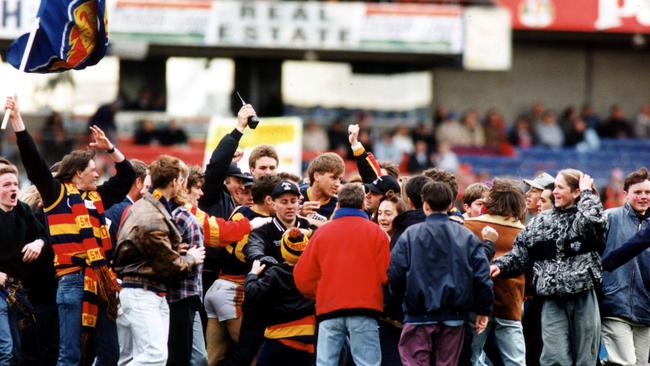
He recalls Cornes’s sons, future Port Adelaide stars Chad and Kane, running onto the oval to celebrate.
Modra became the first player since Hawthorn’s Peter Hudson in 1968 to kick more than 100 goals in their second season and the inaugural Crow to reach the milestone.
“I’d done it a couple of years earlier up in Renmark and you look back and realise now it (kicking 100 in an AFL season) is a pretty good achievement,” he says.
“But when you’re going through every week, it was just a little bonus.”
Ablett pipped Modra to win that year’s Coleman Medal.
“That didn’t bother me, a bit like the Mark of the Year in 1994 … I lost it to a great player,” he says.
“Ablett, Lockett and Dunstall, those guys set the standard so high and raised the standard so much that when you’re out there, you’re just trying your hardest to keep up with them.”

RUBBING SHOULDERS WITH LEGENDS
Modra became stablemates with his goalkicking rivals when he joined player agent Ricky Nixon’s Club 10 group.
“I remember flying over to Melbourne and going into an office and seeing some of those guys around a table and thinking ‘what am I doing here?’ Modra recalls.
“One day I got a lift with Gary Ablett down in Geelong, where we had a photo shoot.
“He was in the old Ford Falcon because they were sponsored by Ford and he had the baby seats in the back.
“He asked me if I wanted something to eat halfway down, we stopped at a cafe, you walk in with him, go to pay and he said ‘you don’t have to worry about that’, which was good.
“I think the cafe must have sponsored him.”
FINALS HEARTBREAK
Adelaide’s march to its first finals series had some Crows people thinking the club could win the premiership.
Particularly when it was beating Essendon by 42 points at halftime of the preliminary final at the MCG.
“I was a true believer we were going to win it,” says Modra, who booted six goals that day.
“But a few things changed, the ball didn’t come down there as much.
“When you look back at it now, we probably could’ve made a few changes.
“I always tell Cornesy he should’ve left Scotty Hodges on because I got double-teamed after that.
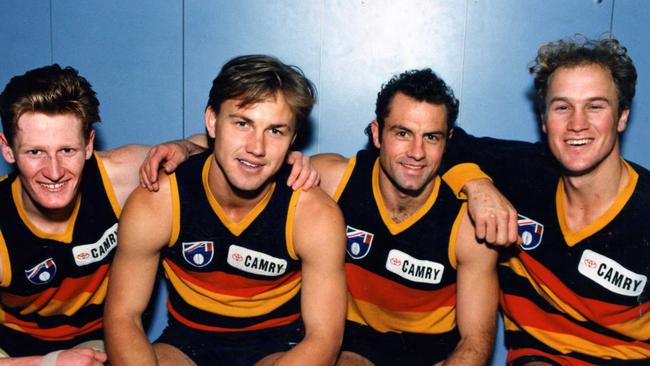
“He didn’t think that was the case.
“I was always a fan of Scotty’s and always thought I was the forward pocket player and he was the full-forward.
“I was happy for it to be that way and still think it could’ve been if the coach did it differently.”
Essendon stormed home after halftime to win by 11 points and went on to claim the flag.
Modra, an All-Australian and state-of-origin player that year, says it is hard not to look back at the preliminary final as a missed opportunity for the club.
“But obviously we got our own back in ‘97 and ‘98,” he says.
REFLECTIONS
Highlights of Modra’s 1993 season bob up in his household every so often thanks to his children Hayley, 15, and Luke, 11.
“Luke does (watch) every now and then, and Hayley sees some of it on Instagram,” says Modra, who retired in 2001 after 588 goals in 165 matches and also played with Fremantle.
“They show me and I just laugh.
“Time flies.
“I’m surprised it’s in colour.”

The family lives on a property on the Fleurieu Peninsula.
Just the other day, Modra had a kick of the footy – at home with Luke, a Goodwood Saints junior and national tennis development squad member.
Modra describes the 1993 season as the time of his life.
“But I didn’t think much of it back then,” he says.
“I was just playing football and enjoying it, going surfing in my spare time with Erica, having a ball.”



